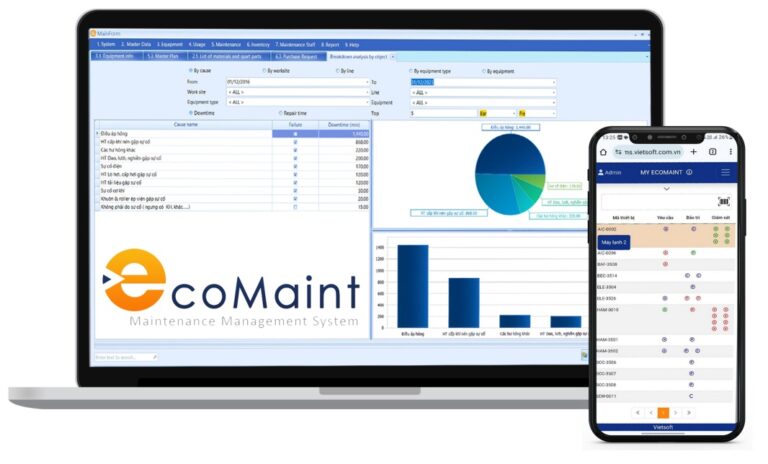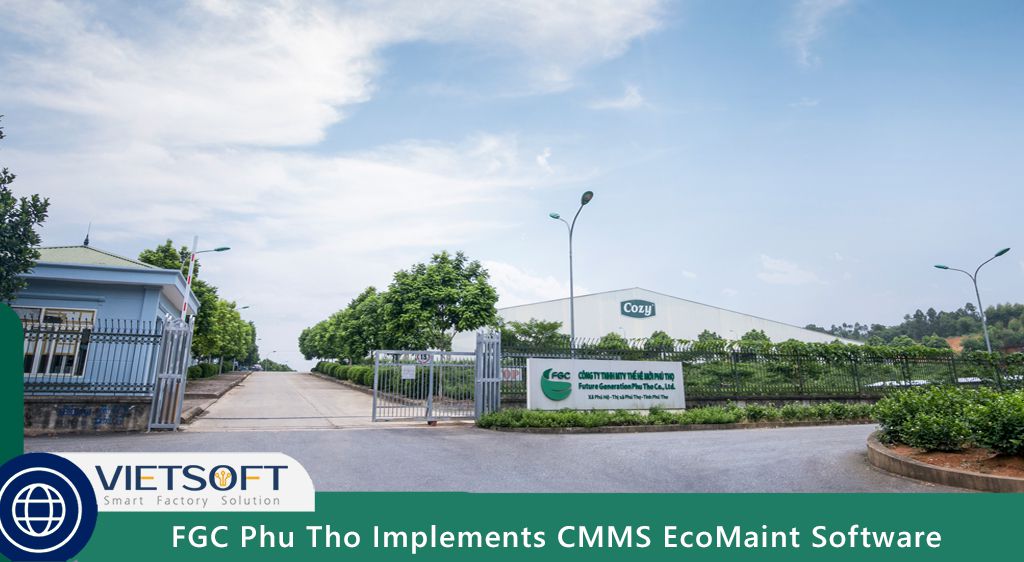
In the realm of industrial maintenance and facility management, a Work Order in Maintenance serves as the cornerstone of an efficient and organized operation. It acts as a structured blueprint that guides maintenance teams through critical tasks to ensure equipment reliability, safety, and operational efficiency. Whether you’re managing a manufacturing plant, a commercial facility, or a healthcare institution, understanding the role and intricacies of a work order is essential for optimizing maintenance processes.
This article delves into the concept of a Work Order in Maintenance, its lifecycle, types, best practices, and the transformative impact of modern solutions like CMMS EcoMaint by Vietsoft.
I. Understanding the Work Order in Maintenance
A Work Order in Maintenance is a formal document—either digital or paper-based—that outlines specific maintenance tasks to be performed on an asset or facility. It provides detailed instructions, resource requirements, and timelines to ensure tasks are completed efficiently and effectively. Work orders are critical for organizing, prioritizing, and tracking maintenance activities, ensuring that equipment remains operational and downtime is minimized.
Work orders are more than just task lists; they are the engine that powers maintenance operations. They enable clear communication between maintenance managers, technicians, and other stakeholders, ensuring everyone is aligned on objectives and expectations. A well-crafted work order includes:
- Task Description: Clear, step-by-step instructions for completing the task.
- Asset Information: Details about the equipment or system, including serial numbers, location, and relevant manuals.
- Priority Level: Indication of urgency (e.g., high, medium, low).
- Assigned Technician(s): Names and contact details of personnel responsible for the task.
- Required Resources: Tools, spare parts, or materials needed.
- Safety Protocols: Specific safety procedures to mitigate risks.
- Timelines: Creation date, expected completion date, and estimated hours.
- Completion Checklist: Steps to verify successful task completion.
By providing a structured framework, work orders help maintenance teams avoid confusion, reduce errors, and maintain a historical record of maintenance activities for future reference.
II. The Role of Work Orders in Modern Maintenance
In today’s fast-paced industrial environment, the Work Order in Maintenance plays a pivotal role in achieving operational excellence. Here are some key reasons why work orders are indispensable:
1. Improved Task Organization: Work orders centralize all task-related information, ensuring technicians have everything they need to execute their duties efficiently.
2. Enhanced Accountability: By specifying who requested, approved, and executed the task, work orders promote transparency and accountability.
3. Minimized Downtime: Prioritizing tasks based on urgency and asset criticality helps prevent costly equipment failures and production delays.
4. Regulatory Compliance: Work orders document maintenance activities, making it easier to comply with industry standards and pass audits.
5. Data-Driven Insights: Tracking work order metrics, such as Mean Time to Repair (MTTR) or schedule compliance, provides valuable insights for continuous improvement.
In the context of modern maintenance, work orders are increasingly managed through digital platforms like CMMS (Computerized Maintenance Management Systems), which streamline processes and enhance data accessibility.
III. Types of Work Orders in Maintenance
Maintenance programs utilize various types of work orders, each tailored to specific needs and scenarios. Understanding these types is crucial for effective maintenance management.
1. Preventive Maintenance Work Orders
Preventive maintenance work orders are scheduled tasks designed to proactively maintain equipment and prevent unexpected failures. These work orders are based on time-based or usage-based triggers, such as regular inspections or servicing after a set number of operating hours. For example, a preventive maintenance work order might instruct a technician to lubricate a motor every 500 hours of operation to extend its lifespan.
2. Corrective Maintenance Work Orders
Corrective maintenance work orders address issues identified during inspections or routine operations. Unlike emergency work orders, these are planned tasks to fix non-critical problems before they escalate. For instance, a technician might notice a worn belt during a routine check and issue a corrective work order to replace it.
3. Emergency Maintenance Work Orders
Emergency work orders are issued when critical assets fail, causing significant production delays or safety hazards. These high-priority tasks require immediate action. An example might be a work order to repair a broken conveyor belt that halts production in a manufacturing plant.
4. Inspection Work Orders
Inspection work orders involve routine audits to assess the condition of assets. These are often part of a predictive or preventive maintenance strategy to identify potential issues early. For example, an inspection work order might require a technician to check the pressure levels of a boiler system monthly.
5. Safety Work Orders
Safety work orders focus on mitigating workplace hazards, such as chemical spills, fire risks, or structural damage. These are critical for ensuring employee safety and regulatory compliance. For instance, a safety work order might instruct technicians to repair a leaking pipe to prevent slips and falls.
6. Electrical Work Orders
Electrical work orders address maintenance tasks related to electrical systems, such as wiring repairs, lighting installations, or power supply maintenance. These require specialized skills and adherence to strict safety protocols.
7. General Work Orders
General work orders cover tasks that don’t fit into other categories, such as decommissioning equipment, painting, or setting up new machinery. These are typically low-priority but essential for overall facility management.
8. Special Project Work Orders
Special project work orders are issued for upgrades or improvements, such as installing new equipment or modernizing facilities to enhance productivity. These tasks often involve multiple departments and require careful planning.
IV. The Work Order Lifecycle: From Creation to Completion
The lifecycle of a Work Order in Maintenance follows a structured process that ensures tasks are identified, executed, and documented efficiently. Below is a detailed breakdown of the seven key phases:
Phase 1: Task Identification
The lifecycle begins when a maintenance need is identified. This could be a proactive task (e.g., scheduled maintenance) or a reactive one (e.g., a sudden equipment failure). For example, a machine operator might notice unusual vibrations and report the issue, triggering a work order.
Phase 2: Work Request Submission
A work request is submitted to the maintenance team, providing preliminary details about the issue. This request is typically less detailed than a work order but serves as the initial notification. For instance, a request might note, “Pump X is making unusual noises.”
Phase 3: Work Request Evaluation
The maintenance manager reviews the request to determine its validity and priority. Factors such as asset criticality, potential downtime costs, and safety risks are considered. If approved, the request is converted into a work order.
Phase 4: Work Order Creation
The manager creates a detailed work order, including task instructions, required resources, safety protocols, and timelines. For example, a work order for a pump repair might include a checklist, a diagram of the pump, and a list of required tools.
Phase 5: Work Order Assignment
The work order is assigned to a qualified technician or team. The assignment considers the technician’s skills, availability, and the task’s urgency. Digital CMMS platforms like EcoMaint can automate this process, ensuring optimal resource allocation.
Phase 6: Task Completion and Documentation
The technician completes the task, following the work order’s instructions. Upon completion, they document details such as time spent, materials used, and any observations. For example, a technician might note that a replaced bearing resolved the vibration issue.
Phase 7: Work Order Review and Analysis
After closure, the work order is reviewed to assess performance and identify improvement opportunities. Metrics like MTTR or schedule compliance are analyzed to refine maintenance strategies. This phase also helps identify recurring issues that may require preventive measures.
V. Best Practices for Effective Work Order Management
To maximize the efficiency of a Work Order in Maintenance, organizations should adopt the following best practices:
1. Standardize the Work Order Process
Develop standardized templates and procedures for creating, assigning, and closing work orders. Consistency reduces errors and ensures all necessary details are included. For example, a standardized template might include fields for asset details, task priority, and safety instructions.
2. Set Clear Goals and KPIs
Define maintenance goals, such as reducing downtime by 20% or achieving 95% schedule compliance. Key Performance Indicators (KPIs) like MTTR, Mean Time Between Failures (MTBF), and work order completion rates should be tracked to measure progress.
3. Define Roles and Responsibilities
Clearly outline who is responsible for each phase of the work order lifecycle, from request submission to task completion. This prevents duplication of efforts and ensures accountability.
4. Adopt a Proactive Maintenance Approach
Shift from reactive to proactive maintenance by leveraging preventive and predictive strategies. For example, use IoT sensors to monitor equipment health and trigger work orders before failures occur.
5. Leverage CMMS Software
Implementing a Computerized Maintenance Management System (CMMS) like EcoMaint by Vietsoft can revolutionize work order management. CMMS platforms automate task assignment, track real-time data, and provide insights for continuous improvement.
VI. 9 Tips for Writing an Effective Work Order
Creating a clear and comprehensive Work Order in Maintenance is critical for successful task execution. Here are nine practical tips:
1. Include Requester Details: List the name and contact information of the person submitting the request for follow-up questions.
2. Specify Approver Information: Document who authorized the work order to ensure accountability.
3. Assign Technicians Clearly: Include the names and contact details of assigned technicians to streamline communication.
4. Detail the Asset: Provide specific information about the equipment, such as serial numbers or QR codes, to avoid confusion.
5. Provide Step-by-Step Instructions: Include a detailed task description and a checklist to guide technicians through the process.
6. Set Clear Timelines: Specify the creation date, expected completion date, and estimated hours to keep tasks on track.
7. Indicate Priority Levels: Clearly mark the urgency (e.g., high, medium, low) to help managers prioritize tasks.
8. List Required Resources: Include all necessary tools, parts, and materials to prevent delays.
9. Incorporate Visual Aids: Attach diagrams, photos, or videos to clarify complex tasks.
VII. Benefits of Using CMMS for Work Order Management
Traditional methods like paper-based work orders, whiteboards, or spreadsheets have significant limitations, such as lost documents, lack of real-time updates, and difficulty tracking performance. A CMMS like EcoMaint by Vietsoft addresses these challenges and offers numerous benefits:
1. Centralized Data Management: All work order details, asset histories, and maintenance records are stored in one accessible platform.
2. Real-Time Tracking: Technicians can update work order status on mobile devices, providing managers with instant visibility.
3. Reduced Paperwork: Digital work orders eliminate manual data entry, saving time and reducing errors.
4. Improved Budgeting and Planning: Access to historical data and analytics helps organizations allocate resources effectively.
5. Simplified Compliance: Automated documentation ensures maintenance records are audit-ready.
VIII. How CMMS EcoMaint Enhances Work Order Management
For organizations in Vietnam seeking to optimize their maintenance operations, CMMS EcoMaint by Vietsoft offers a powerful solution tailored to the local market. EcoMaint streamlines the entire work order lifecycle, from task identification to analysis, with features like:
- Automated Work Order Creation: Generate work orders based on predefined triggers, such as equipment usage or IoT sensor data.
- Mobile Accessibility: Technicians can access work orders, update statuses, and view asset details on the go.
- Advanced Analytics: Track KPIs like MTTR and MTBF to identify trends and optimize maintenance strategies.
- Inventory Management: Ensure the right parts are available by integrating inventory tracking with work orders.
- Customizable Templates: Create standardized work order formats to ensure consistency across teams.
By adopting EcoMaint, businesses can reduce downtime, improve technician productivity, and achieve significant cost savings. Discover the CMMS EcoMaint solution here.
Contact us for consultation via hotline: 0986778578 or email: sales@vietsoft.com.vn.
IX. Common Challenges and Solutions in Work Order Management
While work orders are essential, organizations often face challenges in managing them effectively. Here are some common issues and solutions:
Challenge 1: Incomplete Work Orders
Solution: Use standardized templates with mandatory fields to ensure all critical information is included.
Challenge 2: Miscommunication Between Teams
Solution: Implement a CMMS to centralize communication and provide real-time updates to all stakeholders.
Challenge 3: Backlog of Work Orders
Solution: Prioritize tasks based on urgency and asset criticality, and use predictive maintenance to reduce reactive work orders.
Challenge 4: Lack of Historical Data
Solution: Store all work orders in a digital CMMS to build a comprehensive maintenance history for analysis.
Challenge 5: Technician Overload
Solution: Use workload balancing features in CMMS platforms to assign tasks based on technician availability and skills.
X. The Future of Work Orders in Maintenance
As industries embrace Industry 4.0, the Work Order in Maintenance is evolving with advancements in technology. Key trends include:
- IoT Integration: Sensors provide real-time data to trigger work orders automatically when equipment conditions deviate from norms.
- Predictive Maintenance: Machine learning algorithms analyze historical work order data to predict failures and optimize maintenance schedules.
- Mobile-First Solutions: Technicians access work orders on mobile devices, enabling faster response times and real-time updates.
- Augmented Reality (AR): AR tools provide technicians with visual guidance for complex tasks, improving accuracy and efficiency.
By leveraging these technologies, organizations can transition from reactive to predictive maintenance, reducing costs and enhancing asset reliability.
XI. Conclusion
A Work Order in Maintenance is more than a document—it’s a critical tool that drives efficiency, accountability, and reliability in maintenance operations. By understanding its types, lifecycle, and best practices, organizations can optimize their maintenance processes and minimize downtime. Solutions like CMMS EcoMaint by Vietsoft take work order management to the next level, offering automation, real-time tracking, and actionable insights tailored to the Vietnamese market.
Ready to transform your maintenance operations? Explore how CMMS EcoMaint can streamline your work order processes and drive operational excellence.




